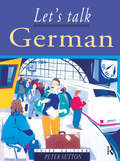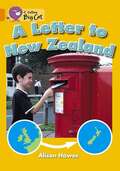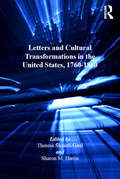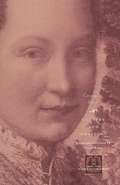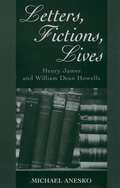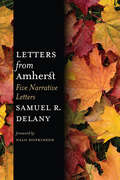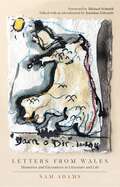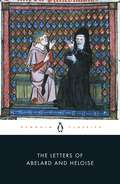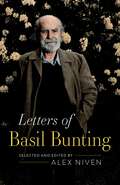- Table View
- List View
Let's Talk: How English Conversation Works
by David CrystalBanter, chit-chat, gossip, natter, tete-a-tete: these are just a few of the terms for the varied ways in which we interact with one another through conversation. David Crystal explores the factors that motivate so many different kinds of talk and reveals the rules we use unconsciously, even in the most routine exchanges of everyday conversation. We tend to think of conversation as something spontaneous, instinctive, habitual. It has been described as an art, as a game, sometimes even as a battle. Whichever metaphor we use, most people are unaware of what the rules are, how they work, and how we can bend and break them when circumstances warrant it.
Let's Talk German: Pupil's Book 3rd Edition
by Peter SuttonA German language course for adult beginners, both independent learners and those following adult education courses. It has been updated to reflect developments in the language and culture of German-speaking nations, and also the political changes in Germany. Audio files to accompany the book are available to download from www.routledge.com/cw/sutton .
Let's Talk German: Pupil's Book 3rd Edition
by Peter SuttonA German language course for adult beginners, both independent learners and those following adult education courses. It has been updated to reflect developments in the language and culture of German-speaking nations, and also the political changes in Germany. Audio files to accompany the book are available to download from www.routledge.com/cw/sutton .
The Letter of Violence: Essays on Narrative, Ethics, and Politics (New Directions in Latino American Cultures)
by I. AvelarThis book traces the theory of violence from nineteenth-century symmetrical warfare through today's warfare of electronics and unbalanced numbers. Surveying such luminaries as Walter Benjamin, Frantz Fanon, Hannah Arendt, Paul Virilio, and Jacques Derrida, Avelar also offers a discussion of theories of torture and confession, the work of Roman Polanski and Borges, and a meditation on the rise of the novel in Colombia.
A Letter To New Zealand: Band 06/orange (Collins Big Cat Ser.)
by Alison Hawes Cliff Moon Collins Big CatHave you ever wondered what happens when you drop your letter in the postbox? How does a letter get from your home town to the other side of the world in just a few days? In this book you will see what happens at every stage of a letter's journey from Jack in England to his penpal, Tama, in New Zealand. Orange/ Band 6 books offer varied text and characters, with action sustained over several pages. Text type - A recount/ explanation text. At the end of the book is a useful timeline showing a summary of each step, which can be used to recap the procedure orally or to support children's writing outside the reading session. Curriculum links - Geography: Other people and places; Citizenship: People who help us. This book has been levelled for Reading Recovery. This book has been quizzed for Accelerated Reader.
Letter Writing Among Poets: From William Wordsworth to Elizabeth Bishop (Edinburgh University Press)
by Jonathan EllisFifteen enlightening chapters by leading international biographers, critics and poets examine letter writing among poets in the last two hundred years. They range from Coleridge, Wordsworth, Keats and Shelley in the nineteenth-century to Eliot, Yeats, Bishop and Larkin in the twentieth. In doing so, they respond to the following questions. Who are the great letter writers of the past? Why is reading other people’s mail so addictive? What is the relationship between letter writing and other literary genres such as poetry? Divided into three sections—Contexts and Issues, Romantic and Victorian Letter Writing, and Twentieth-Century Letter Writing—the volume demonstrates that real letters still have an allure that virtual post struggles to replicate.
Lettering Young Readers in the Dutch Enlightenment: Literacy, Agency and Progress in Eighteenth-Century Children’s Books (Palgrave Studies in the History of Childhood)
by Feike Dietz'This book presents a rigorous, hugely informative analysis of the early history of Dutch children’s literature, pedagogical developments and emerging family formations. Thoroughly researched, Dietz’s study will be essential for historians of eighteenth-century childhood, education and children’s books, both in the Dutch context and more widely.’— Matthew Grenby, Newcastle University, UK. ‘A rich, informative, well-documented and effectively illustrated discussion of the ways Dutch eighteenth-century educators tried to transform youth into responsible readers. It does so in a wide international context and masterfully connects this process to the radical politicization and de-politicization of Dutch society in the revolutionary period.’—Wijnand W. Mijnhard, formerly of Utrecht University, the Netherlands, and theUniversity of California at Los Angeles, USA.This book explores how children’s literature and literacy could at once regulate and empower young people in the eighteenth-century Dutch Republic. Rather than presenting the history of childhood as a linear story of increasing agency, it suggests that we view it as a continuous struggle with the impossibility of full agency for young people. This volume demonstrates how this struggle informed the production of books in a historical context in which the development of independent youths was high on the political agenda. In close interaction with international children’s literature markets, Dutch authors developed new strategies to make the members of young generations into capable readers and writers, equipped to organize their own minds and bodies properly, and to support a supposedly declining fatherland.
Letters
by Arthur SymonsA selection of letters by the symbolist critic and poet, Arthur Symons (1865-1945), including correspondence with such figures as James Joyce, W.B.Yeats, Joseph Conrad, Paul Verlaine, Edmund Gosse, Thomas Hardy and Augustus John to reveal the world of literary London at the turn of the century.
Letters across Borders: The Epistolary Practices of International Migrants
by B. Elliot D. Gerber S. SinkeThis collection addresses the recent rebirth of interest in immigrant letters. As these letters are increasingly seen as key, rather than incidental, documents in the interpretations of gender, age, social class, and ethnicity/nationality, the scholars gathered here demonstrate a diversity of new approaches to their interpretation.
Letters and Cultural Transformations in the United States, 1760-1860
by Sharon M. HarrisThis volume illustrates the significance of epistolarity as a literary phenomenon intricately interwoven with eighteenth- and nineteenth-century cultural developments. Rejecting the common categorization of letters as primarily private documents, this collection of essays demonstrates the genre's persistent public engagements with changing cultural dynamics of the revolutionary, early republican, and antebellum eras. Sections of the collection treat letters' implication in transatlanticism, authorship, and reform movements as well as the politics and practices of editing letters. The wide range of authors considered include Mercy Otis Warren, Charles Brockden Brown, members of the Emerson and Peabody families, Margaret Fuller, Elizabeth Stoddard, Catherine Brown, John Brown, and Harriet Jacobs. The volume is particularly relevant for researchers in U.S. literature and history, as well as women's writing and periodical studies. This dynamic collection offers scholars an exemplary template of new approaches for exploring an understudied yet critically important literary genre.
Letters and Cultural Transformations in the United States, 1760-1860
by Sharon M. HarrisThis volume illustrates the significance of epistolarity as a literary phenomenon intricately interwoven with eighteenth- and nineteenth-century cultural developments. Rejecting the common categorization of letters as primarily private documents, this collection of essays demonstrates the genre's persistent public engagements with changing cultural dynamics of the revolutionary, early republican, and antebellum eras. Sections of the collection treat letters' implication in transatlanticism, authorship, and reform movements as well as the politics and practices of editing letters. The wide range of authors considered include Mercy Otis Warren, Charles Brockden Brown, members of the Emerson and Peabody families, Margaret Fuller, Elizabeth Stoddard, Catherine Brown, John Brown, and Harriet Jacobs. The volume is particularly relevant for researchers in U.S. literature and history, as well as women's writing and periodical studies. This dynamic collection offers scholars an exemplary template of new approaches for exploring an understudied yet critically important literary genre.
Letters and Literacy in Hollywood Film (Palgrave Close Readings in Film and Television)
by E. GallafentWe are so used to images of words that it is easy to ignore the different ways in which they work in films. This book explores both the letters that come in the post and the many other kinds that are offered to us on screen.
Letters and Lives of the Tennyson Women
by Marion Sherwood Rosalind BoyceContradicting common perception of them as mere footnotes in Tennyson's career, this book examines the influence of his strong-minded female forebears on the young poet and reveals that the women in Tennyson's family circle were prolific and engaging correspondents. Their letters, preserved in archives in Lincoln and for the most part unpublished, cast a unique light on the Tennyson family's interrelationships and the times in which they lived.Focusing on the letters and lives of four Tennyson women – the poet's paternal grandmother, Mary Tennyson (1753-1825), her daughters Elizabeth Russell (1776-1865) and Mary Bourne (1777-1864), and her daughter-in-law Frances Tennyson, later Tennyson d'Eyncourt (1787-1878) - this book includes extensive and annotated extracts from the women's letters, linked by narrative passages providing context and continuity. The case studies cover six decades, from the marriage of Mary Turner and George Tennyson in 1775 to the death of George Tennyson in 1835, with brief Afterwords touching on the women's final years.
Letters and Lives of the Tennyson Women
by Marion Sherwood Rosalind BoyceContradicting common perception of them as mere footnotes in Tennyson's career, this book examines the influence of his strong-minded female forebears on the young poet and reveals that the women in Tennyson's family circle were prolific and engaging correspondents. Their letters, preserved in archives in Lincoln and for the most part unpublished, cast a unique light on the Tennyson family's interrelationships and the times in which they lived.Focusing on the letters and lives of four Tennyson women – the poet's paternal grandmother, Mary Tennyson (1753-1825), her daughters Elizabeth Russell (1776-1865) and Mary Bourne (1777-1864), and her daughter-in-law Frances Tennyson, later Tennyson d'Eyncourt (1787-1878) - this book includes extensive and annotated extracts from the women's letters, linked by narrative passages providing context and continuity. The case studies cover six decades, from the marriage of Mary Turner and George Tennyson in 1775 to the death of George Tennyson in 1835, with brief Afterwords touching on the women's final years.
Letters and Orations (The Other Voice in Early Modern Europe)
by Cassandra FedeleBy the end of the fifteenth century, Cassandra Fedele (1465-1558), a learned middle-class woman of Venice, was arguably the most famous woman writer and scholar in Europe. A cultural icon in her own time, she regularly corresponded with the king of France, lords of Milan and Naples, the Borgia pope Alexander VI, and even maintained a ten-year epistolary exchange with Queen Isabella and King Ferdinand of Spain that resulted in an invitation for her to join their court. Fedele's letters reveal the central, mediating role she occupied in a community of scholars otherwise inaccessible to women. Her unique admittance into this community is also highlighted by her presence as the first independent woman writer in Italy to speak publicly and, more importantly, the first to address philosophical, political, and moral issues in her own voice. Her three public orations and almost all of her letters, translated into English, are presented here for the first time.
Letters between Forster and Isherwood on Homosexuality and Literature
by R. ZeikowitzThis original analysis of correspondence between E.M. Forster and Christopher Isherwood illuminates how these two influential writers grappled with WII, their personal relationships, and their creative works.
Letters, Fictions, Lives: Henry James And William Dean Howells
by Michael AneskoIn this unique and long-awaited volume, Michael Anesko documents the literary cross-fertilization between Henry James and William Dean Howells, collecting 151 letters, nearly all the extant correspondence between the two men, as well as the most significant critical commentary James wrote on Howells and Howells wrote on James. Scholars have long recognized the peculiar importance of the relationship between these two exponents of realistic fiction--their mutual respect and occasional animosity. But the record of their affinities and substantial differences has never before been so amply and compellingly established. Containing dozens of previously unpublished letters by James, and featuring a detailed biographical chronology as well as extensive interpretive commentaries that meticulously chart the development of this remarkable literary friendship,Letters, Fictions, Lives, edited to the highest standards of scholarly excellence, will prove an invaluable resource for scholars and students of James and Howells, and will hold great interest for dedicated readers of their fiction and for those studying epistolary issues and literary influence between contemporaries.
Letters from Amherst: Five Narrative Letters
by Samuel R. DelanyFive substantial letters written from 1989 to 1991 bring readers into conversation with Hugo and Nebula Award winning-author Samuel Delany. With engaging prose, Delany shares details about his work, his relationships, and the thoughts he had while living in Amherst and teaching as a professor at the UMASS campus just outside of town, in contrast to the more chaotic life of New York City. Along with commentary on his own work and the work of other writers, he ponders the state of America, discusses friends who are facing AIDS and other ailments, and comments on the politics of working in academia. Two of the letters, which tell the story of his meeting his life partner Dennis, became the basis of his 1995 graphic novel, Bread & Wine. Another letter describes the funeral of his uncle Hubert T. Delany, former judge and well-known civil rights activist, and leads to reflections on his family's life in 1950s Harlem. Another details a visit from science fiction writer and critic Judith Merril, and in another he gives a portrait of his one-time student Octavia E. Butler, who by then has become his colleague. In addition, an appendix shares ten letters Delany sent to his daughter while she attended summer camp between 1984 and 1988. These letters describe Delany's daily life, including visitors to his upper-west-side apartment, his travels for work and pleasure, lectures attended, movies viewed, and exhibits seen.
Letters from England: by Don Manuel Alvarez Espriella (The Pickering Masters)
by Carol BoltonIn 1807 Robert Southey published a pseudonymous account of a journey made through England by a fictitious Spanish tourist, ‘Don Manuel Alvarez Espriella’. Letters from England (1807) relates Espriella’s travels. On his journey Espriella comments on every aspect of British society, from fashions and manners, to political and religious beliefs.
Letters from England: by Don Manuel Alvarez Espriella (The Pickering Masters)
by Carol BoltonIn 1807 Robert Southey published a pseudonymous account of a journey made through England by a fictitious Spanish tourist, ‘Don Manuel Alvarez Espriella’. Letters from England (1807) relates Espriella’s travels. On his journey Espriella comments on every aspect of British society, from fashions and manners, to political and religious beliefs.
Letters from Wales: Memories and Encounters in Literature and Life
by Sam Adams'Letters from Wales stands alone as an invaluable guide to Welsh writing.' – Sam Young, Wales Arts Review 'In these columns, as impressive for their depth as they are for their intellectual breadth, Adams analyses the work of acclaimed Welsh writers ... with scholarly panache' – Joshua Rees, Buzz Magazine 'illuminating and entertaining' – Jon Gower, Nation.Cymru Since 1996, Sam Adams's 'Letter from Wales' column has been appearing in PN Review, one of the most highly-regarded UK poetry magazines, offering insight and appreciation of Welsh writing, culture and history. This landmark volume collects these letters – a quarter century of work – and offers one of the most unique, independent and passionate critical voices on the writing and cultural output of Wales during this period. Here you will find erudite appreciations of the work of a wide range of recent and contemporary Welsh writers from Gillian Clarke to Roland Mathias, RS Thomas to Rhian Edwards. Alongside this, Adams offers us lyric essays to Welsh history, and clear-eyed examinations of the institutions of Welsh culture. Collected for the first time in this volume, the 'letters' are among the most significant and sustained attempts during this period to present Welsh writing to an audience throughout the UK and beyond.
The Letters of Abelard and Heloise: Tr. From The Original Latin And Now Reprinted From The Edition Of 1722 (Christian Classics Ser.)
by Betty Radice Peter Abelard Michael ClanchyThe story of Abelard and Heloise remains one of the world's most celebrated and tragic love affairs. Through their letters, we follow the path of their romance from its reckless and ecstatic beginnings when Heloise became Abelard's pupil, through the suffering of public scandal and enforced secret marriage, to their eventual separation.
Letters of Basil Bunting
An edition of the letters of the poet Basil Bunting (1900-1985). This is a long-awaited first selected edition of the letters of Basil Bunting, one of the major modernist poets of the twentieth century. It includes a large portion of Bunting's correspondence (around 200 letters) to recipients including Ezra Pound, T. S. Eliot, Harriet Monroe, William Carlos Williams, Louis Zukofsky, Ted Hughes, George Oppen, Allen Ginsberg, Donald Davie, and Tom Pickard. Following Bunting from his first encounters with major literary figures in London and Paris in the 1920s to his death in Northumberland in 1985, this selection showcases a narrative that is crucial to the history of modernism and modern poetry in English. Highlights include a long and detailed dialogue with Ezra Pound in the 1930s on political, economic, and literary subjects, a rich, ruminative exchange with the American poet Louis Zukoksfy lasting over four decades, and various accounts of the excitements and controversies of the Anglo-American poetry scene of the 60s and 70s. Whether Bunting is writing from New York at the height of the Depression, Iran in the aftermath of World War II, or the north of England during preparation of his masterpiece Briggflatts (1966), his prose is unfailingly sharp, eloquent, entertaining, and caustic. This edition contains detailed annotations of Bunting's letters, a critical introduction, glossary of names, and an editorial commentary.
The Letters of Brendan Behan
by Brendan BehanA critical study of author Brendan Behan and his work, through collected letters, correspondence, material from previous publications and personal reminiscences. E.H.Mikhail has published work on other literary figures including "James Joyce: Interviews and Recollections".
The Letters of Dr Charles Burney: Volume III: 1794-1800
by Charles Burney Alvaro Ribeiro Lorna J. Clark Stewart J. Cooke Nancy Johnson Peter SaborThis volume of letters by Charles Burney, the first to be published since 1991, runs from 1794 to 10 January 1800, beginning with his recovery from a debilitating attack of rheumatism, continuing with the death of his wife in 1796, and ending with the shocking death of his daughter Susanna. Certain leitmotifs, typical of Burney's concerns, stand out throughout the volume: his trepidation over the war with France and its effect on domestic politics, his exhausting social life, his travels, and his publication of the memoirs of the poet and lyricist Metastasio. A staunch monarchist and a self-confessed 'allarmist', Burney is haunted 'day and night' by the French Revolution and the threat that Republican France poses to 'religion, morals, liberty, property, & life'. He frets frequently over those he considers to be domestic Jacobins, a word he uses forty-seven times in the course of the volume to describe anyone whose politics differ from his own conservative values. Although Burney turns sixty-eight in April 1794, in this volume he barely slows down his habitual hectic pace of teaching and publishing. In the summer of 1795, he publishes his final book, Memoirs of the Life and Writings of the Abate Pietro Metastasio, despite a hectic social life that sees him hobnobbing with the elite in society and politics and a love of travel that takes him to the homes of friends in Hampshire and Cheshire and into his past on a nostalgic visit to Shrewsbury, his childhood home.

